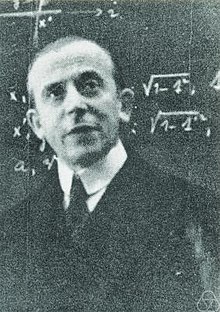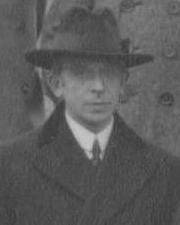Richard von Mises
Richard Edler von Mises (born April 19, 1883 in Lemberg , Galicia , Austria-Hungary , † July 14, 1953 in Boston , Massachusetts , United States ) was an Austrian -American mathematician . He is the brother of the economist Ludwig von Mises .
Life
Richard von Mises studied mathematics, physics and engineering at the Vienna University of Technology . After graduating, he became Georg Hamel's assistant at the Technical University in Brno . In 1907 he received his doctorate at the Vienna University of Technology, followed by his habilitation in Brno in 1908 . He then worked as a lecturer in Brno. In 1909 he became an associate professor of applied mathematics at the University of Strasbourg .
During the First World War he served in the Austro-Hungarian army. Because of his knowledge of aircraft construction and his training as a pilot, he worked there as a test pilot and trainer. He led the development of a new airplane ("Mises airplane"), which was completed in 1916, but was not used.
After the war, from 1919 to 1920, he was professor of strength, hydrodynamics and aerodynamics at the Technical University of Dresden . In 1920 he moved to the University of Berlin , where he became director of the Institute for Applied Mathematics. In 1923 he was elected a member of the Leopoldina .
After the National Socialists came to power in Germany in 1933, von Mises, who had been baptized Catholic, was initially not removed from his chair despite his Jewish origins , as there was an exception for those involved in the First World War . In addition, von Mises was known for his more German-national views. Because of the insecurity and intolerance of this situation, he emigrated to Turkey in 1933 and took over a chair for pure and applied mathematics in Istanbul . Von Mises resigned from his professorship in Istanbul in protest against the non-renewal of the employment of his colleague Hilda Geiringer . Since he also feared for the political future of Turkey after the death of Kemal Ataturk , he accepted an invitation to Harvard University in 1939 , where he did not receive a full professorship until 1945. During World War II he worked as a civilian for the US Army. In 1946 he became a US citizen.
In 1943 he married the mathematician Hilda Geiringer, who had to leave the university in 1933 as a Jew and accompanied von Mises to Turkey and later to the USA.
plant
His main areas of work were numerical mathematics , fluid mechanics, aerodynamics, statistics and probability theory . In his work The Basis of Probability Calculation , published in 1919, he attempted to define probability using the analytical concept of limit values . This was discussed a lot at the time, but overtaken and superseded by the axiomatization of the probability theory by Andrei N. Kolmogorow (1933).
An effort hypothesis for tough materials in plasticity theory is named after him . With the so-called “shape change energy hypothesis (GEH)”, the Mises equivalent stress can be calculated for a 3D stress state - with this, the stress limit in the material (flow, fracture) can be determined for combined loads.
The Von Mises iteration for calculating the greatest magnitude eigenvalue of a matrix is also from him; He also succeeded in a first systematic approach to the treatment of structural problems with the help of matrices (matrix statics).
The Von Mises distribution he introduced is one of the most important distributions in the circle. Their importance in circular statistics is comparable to the importance of the normal distribution for linear data.
Together with his friend Philipp Frank , he gave the textbook The differential and integral equations of mechanics and physics, Volume I: Mathematical Part, Volume II: Physical Part (1st edition 1925, 2nd increased edition 1930, unchanged reprint of the 2nd increased edition 1961, Dover Publications Inc., New York and Friedrich Vieweg & Sohn , Braunschweig).
A compact introduction to the philosophy of science from his point of view, which was largely shaped by the Vienna Circle , is his Small Textbook of Positivism - Introduction to the Empirical Concept of Science , which was first published in 1939. Von Mises was also a great admirer of Rilke and owned one of the largest private collections on the poet.
Honor
In 1944, von Mises was elected to the American Academy of Arts and Sciences . In 2015, a building on the TU Dresden campus was renamed " von Mises-Bau ". Since 1989 the German Society for Applied Mathematics and Mechanics (GAMM) has awarded the “Richard von Mises Prize”. In 1950 he was offered admission to the East Berlin- based German Academy of Sciences , but to his regret he had to decline in the climate of the Cold War and the McCarthy era .
literature
- Rudolf Nissen : Light leaves, dark leaves. (Autobiography) DVA 1969, Herder-Buchgemeinde 1969 and Ecomed, 2001 ISBN 3-609-16029-2 , p. 212.
- Siegmund Kaznelson (ed.): Jews in the German cultural area. A compilation. Jewish publishing house, Frankfurt am Main. 3rd edition 1962, p. 393 f.
- Elke-Vera Kotowski (Ed.): Jews in Berlin. Biographies. Henschel, Berlin 2005, ISBN 3-89487-461-9 , p. 197 f. (See also the critical review of the entire book by Tobias Schenk, online at sehepunkte.de ).
- Reinhard Siegmund-Schultze Indeterminism in Quantum Theory: Richard von Mises' probabilistic purism in the theory of physical processes , in Karl-Heinz Schlote , Martina Schneider (Ed.) Mathematics meets physics: a contribution to their interaction in the 19th and the first half of the 20th century , Frankfurt am Main: Harri Deutsch, 2011, pp. 241–270.
- Karl Märker: Mises, Richard. In: New German Biography (NDB). Volume 17, Duncker & Humblot, Berlin 1994, ISBN 3-428-00198-2 , pp. 564-566 ( digitized version ).
- Hannelore Bernhardt : To compare the probabilistic concepts of R. v. Mises and AN Kolmogorov. Perspectives of intercultural interaction for scientific progress. Contributions from scientific historians of the GDR to the XVIII. International Congress for the History of Sciences in Berkley (USA), Academy of Sciences of the GDR, Institute for the History and Organization of Sciences. Colloquia Booklet 43, pp. 205-209. Berlin 1985.
- Hannelore Bernhardt : Richard von Mises in his time in Berlin. In: Hans Reichenbach and the Berlin group, pp. 101–112. Vieweg & Sohn publishing company, Braunschweig; Wiesbaden 1994.
- Hannelore Bernhardt : Richard von Mises and the Berlin Academy of Sciences. Meeting reports of the Leibniz Society of Sciences in Berlin , Volume 64, pp. 180–185. trafo Wissenschaftsverlag Dr. Wolfgang Weist, Berlin 2004.
Web links
- Literature by and about Richard von Mises in the catalog of the German National Library
- John J. O'Connor, Edmund F. Robertson : Richard von Mises. In: MacTutor History of Mathematics archive .
- Biography of Robert Nowlan (pdf)
- Spektrum .de: Richard von Mises (1883–1953) April 1, 2018
Individual evidence
- ↑ Mises, Richard Edler von . In: Dorit Petschel : 175 years of TU Dresden. Volume 3: The professors of the TU Dresden 1828–2003. Edited on behalf of the Society of Friends and Supporters of the TU Dresden e. V. von Reiner Pommerin , Böhlau, Cologne a. a. 2003, ISBN 3-412-02503-8 , p. 634.
- ↑ Reinhard Siegmund-Schultze Mathematicians fleeing from Nazi Germany , Princeton University Press 2009, p. 383
- ^ Karl-Eugen Kurrer : The History of the Theory of Structures. Searching for Equilibrium . Ernst & Sohn , Berlin 2018, pp. 836f., ISBN 978-3-433-03229-9 .
- ^ German edition at Suhrkamp stw 871, ISBN 978-3-518-28471-1
- ^ Members of the American Academy. Listed by election year, 1900-1949 ( PDF ). Retrieved October 8, 2015
- ↑ see GAMM page about the Richard von Mises Prize Winners, accessed March 9, 2016
| personal data | |
|---|---|
| SURNAME | Mises, Richard of |
| ALTERNATIVE NAMES | Mises, Richard Edler of |
| BRIEF DESCRIPTION | Austrian mathematician |
| DATE OF BIRTH | April 19, 1883 |
| PLACE OF BIRTH | Lviv , Galicia , Austria-Hungary |
| DATE OF DEATH | July 14, 1953 |
| Place of death | Boston , Massachusetts , United States |

